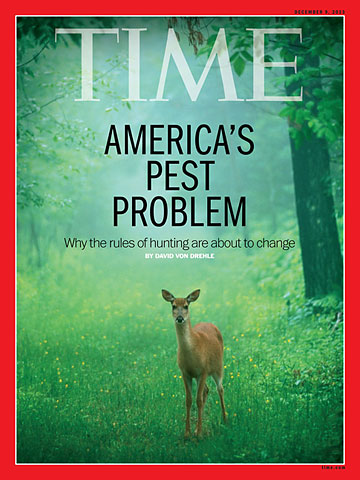
(4 of 7)
Even better for the bears and other wildlife, humans built suburbs next to the forests and threaded them with green space and nature trails, then stocked their neighborhoods with vegetable gardens and fruit trees and big plastic cans full of yummy garbage. At random intervals, they installed even bigger metal dumpsters overflowing with pungent delectables, not to mention pet bowls heaped with kibble and backyard barbecue grills caked with succulent grease. Adult black bears require as much as 20,000 calories a day in autumn to prepare for their long winter naps. That's a lot of bugs, berries and carrion--so much that scientists have determined that Mother Nature's ideal bear population is only about 2½ animals per square mile of forest, depending on the region. The same amount of land, strewn with high-calorie human-supplied treats, can sustain many more bears. And that's where the trouble comes.
As goes New Jersey, so goes America. Already this academic year, suburban grade schools in New Mexico, Colorado, Virginia, Idaho and Florida have ordered lockdowns in response to black bears prowling near the premises. Bears are growing fat on human hospitality from the outskirts of Los Angeles to the Beltway of Washington.
In his book Nature Wars: The Incredible Story of How Wildlife Comebacks Turned Backyards Into Battlegrounds, journalist Jim Sterba documented the superfauna revival and our ambivalent feelings about having them walk among us. "We create all these food sources," he explained in a radio interview. "We put out birdseed. We put out garbage. We grow this beautiful grass and gardens that are full of wonderful, luscious things for wild creatures to eat. Not only that, if an animal shows up that shouldn't be there, we tend to treat it as sort of an outdoor pet. I know people who, when a bear turns up in their garbage, say, 'Oh, get a doughnut.'"
But does that mean the poor bears must be killed? Antihunting activists advocate taking reasonable steps to eliminate the suburban banquet halls in which bears and other fauna now nosh and prosper. We should bear-proof garbage cans, hide pet food and birdseed, lock sheds and garages. All these techniques would help control the population of bears and other wildlife, they argue.
But suppose that all these steps were taken tomorrow and the black bears of New Jersey and elsewhere were instantly restored to their paleo diet. Slow starvation is no happier a way for a bear to die than by a hunter's bullet or arrow. And in the process of starving, animals cut off from their human feed are likely to become increasingly desperate and brazen. They start eating pets instead of pet food. Incidents like this one could become more common: in May, a woman in Altadena, Calif.--a suburb of Los Angeles, near Pasadena--entered her kitchen to find a bear already there, munching on peaches she had left on the counter. When she screamed, the bear reluctantly left the kitchen, ambling outside and flopping on the pool deck for a postprandial snooze.
